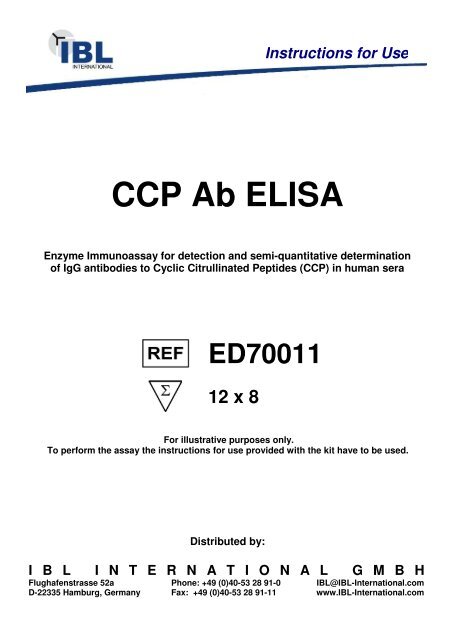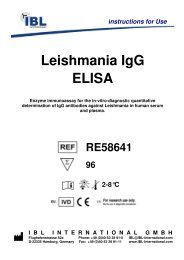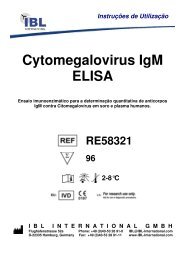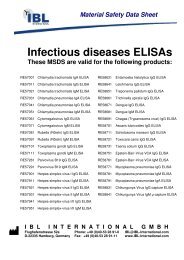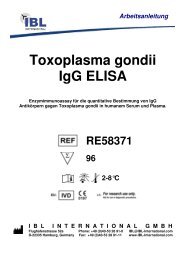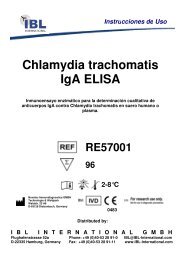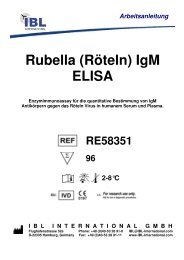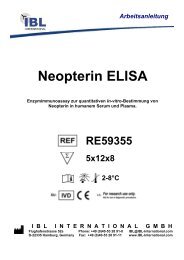CCP Ab ELISA - IBL international
CCP Ab ELISA - IBL international
CCP Ab ELISA - IBL international
You also want an ePaper? Increase the reach of your titles
YUMPU automatically turns print PDFs into web optimized ePapers that Google loves.
Instructions for Use<br />
<strong>CCP</strong> <strong>Ab</strong> <strong>ELISA</strong><br />
Enzyme Immunoassay for detection and semi-quantitative determination<br />
of IgG antibodies to Cyclic Citrullinated Peptides (<strong>CCP</strong>) in human sera<br />
ED70011<br />
12 x 8<br />
For illustrative purposes only.<br />
To perform the assay the instructions for use provided with the kit have to be used.<br />
Distributed by:<br />
I B L I N T E R N A T I O N A L G M B H<br />
Flughafenstrasse 52a Phone: +49 (0)40-53 28 91-0 <strong>IBL</strong>@<strong>IBL</strong>-International.com<br />
D-22335 Hamburg, Germany Fax: +49 (0)40-53 28 91-11 www.<strong>IBL</strong>-International.com
<strong>CCP</strong> <strong>Ab</strong> <strong>ELISA</strong><br />
ENGLISH<br />
1. INTENDED USE<br />
The Anti-<strong>CCP</strong> test kit is an enzyme-linked immunosorbent assay (<strong>ELISA</strong>) for detection and semiquantitation<br />
of IgG antibodies to Cyclic Citrullinated Peptides (<strong>CCP</strong>) in human sera. The assay is<br />
used to detect antibodies in a single serum specimen. The results of the assay are to be used as an<br />
aid to the diagnosis of Rheumatoid Arthritis (RA), in conjunction with other laboratory and clinical<br />
findings. The analysis should be performed by trained laboratory professionals. “For in vitro<br />
diagnostic use”.<br />
2. SUMMARY AND EXPLANATION<br />
Rheumatoid Arthritis (RA) is one of the most common systemic autoimmune diseases. The aetiology<br />
of the disease, which affects up to 1-2% of the world population, is unknown. The diagnosis of RA<br />
depends primarily on clinical manifestation of the disease. The only serological test routinely used is<br />
the determination of the presence of rheumatoid factors (RF) in the serum. RF are antibodies directed<br />
to the constant region of immunoglobulins of the IgG class. However, these antibodies are also<br />
present in relatively high percentages in other autoimmune diseases, infections and in up to 15% of<br />
healthy individuals.<br />
Antibodies of a more specific nature have also been found in sera of RA patients (see (1) for an<br />
overview). Anti-perinuclear factor (APF) antibodies are reported to be present in around 50% of RA<br />
patients with a specificity of over 70% (2). A number of cyclic synthetic peptides not related to<br />
filaggrin or other known proteins were described which are specifically recognized by autoantibodies<br />
in sera from RA patients (3). These peptides were subsequently used in an EIA for the detection of<br />
RA-specific autoantibodies (3). Clinical evaluation studies showed that the EIA was positive in a<br />
significant number of well-defined RA patient sera with an excellent specificity against disease<br />
controls (3-8). A diagnostic and prognostic value for the measurement of the anti Cyclic Citrullinated<br />
Peptides (anti-<strong>CCP</strong>) antibodies was found in relation to joint involvement and radiological damage in<br />
early RA (7, 9-14). Anti-<strong>CCP</strong> antibodies can be detected years before the development of clinical<br />
symptoms (14). A prospective cohort study showed that 93% of the anti-<strong>CCP</strong> positive patients with<br />
undifferentiated arthritis finally developed rheumatoid arthritis, demonstrating the strong positive<br />
predictive value of these antibodies (14). The Anti-<strong>CCP</strong> assay is based on highly purified synthetic<br />
peptides containing citrulline residues and is a valuable addition to the diagnosis of RA. This anti-<br />
<strong>CCP</strong> kit contains improved synthetic peptides selected on the basis of superior performance in the<br />
detection of RA autoantibodies (8-14).<br />
3. PRINCIPLE OF THE RA PEPTIDE EIA<br />
The anti-<strong>CCP</strong> antibody kit is based on an <strong>ELISA</strong> method. The test utilizes microtitre plate wells coated<br />
with citrullinated synthetic peptides (antigen). Diluted patient serum is applied to the wells and<br />
incubated. If specific antibodies are present, they will bind to the antigen in the wells. Unbound<br />
material is washed away and any bound antibody is detected by adding horse radish peroxidase<br />
(HRP) labelled anti-human IgG, followed by a second washing step and an incubation with substrate.<br />
The presence of reacting antibodies will result in the development of colour, which is proportional to<br />
the quantity of bound antibody, and this is determined photometrically.<br />
4. PRECAUTIONS<br />
1. The stop solution contains 0.5 M sulphuric acid. Do not allow the reagent to get into contact with<br />
the skin.<br />
2. Avoid contact of all biological materials with skin and mucous membranes.<br />
3. Do not pipette by mouth.<br />
4. Controls and calibrators contain serum of human origin. Although tested against and confirmed<br />
negative for HIV 1+2, HCV, HbsAg and HIV-1 Ag, this material must be treated as potentially<br />
infectious. - The Centers for Disease Control and Prevention and National Institutes of Health<br />
recommended that potentially infectious agents be handled at the Biosafety Level 2.<br />
V2009_06 1
<strong>CCP</strong> <strong>Ab</strong> <strong>ELISA</strong><br />
ENGLISH<br />
5. TMB (3, 3', 5, 5'-tetramethylbenzidin) is toxic by inhalation, in contact with skin and if swallowed.<br />
Observe care when handling the substrate.<br />
6. Do not use components past the expiration date and do not intermix components from different<br />
lots.<br />
7. Each well is ultimately used as an optical cuvette. Therefore, do not touch the under-surface of<br />
the wells and prevent damage and dirt.<br />
8. Optimal results will be obtained by strict adherence to this protocol. Careful pipetting and washing<br />
throughout this procedure are necessary to maintain precision and accuracy.<br />
9. Calibrators, controls and diluent buffer contain 0.09% sodium azide.<br />
10. It has been reported that sodium azide may react with lead and copper in plumbing to form<br />
explosive compounds. When disposing, flush drains with water to minimize build-up of metal<br />
azide compounds.<br />
11. For in vitro diagnostic use.<br />
5. KIT CONTENTS<br />
Symbol<br />
Ag<br />
CAL<br />
CONTROL +<br />
CONTROL -<br />
CONTROL REF<br />
CONJ<br />
SUBS TMB<br />
BUF WASH 20x<br />
H 2 SO 4 0.5M<br />
DIL<br />
Component<br />
1 Sealed (96 wells) <strong>CCP</strong> peptide-coated<br />
microtitre plate. Ready to use.<br />
5 Vials containing calibrators (positive human<br />
serum pool) (1.2 mL). Ready to use (blue).<br />
1 Vial containing positive control human serum<br />
(1.2 mL). Ready to use (blue). (Value on label in<br />
U/mL).<br />
1 Vial containing negative control human serum<br />
(1.2 mL). Ready to use (blue).<br />
1 Vial containing reference control human serum<br />
(1.2 mL). Ready to use (blue).<br />
1 Vial containing conjugate solution (peroxidase<br />
conjugated to anti human IgG antibodies)<br />
(15 mL). Ready to use (red).<br />
1 Vial containing substrate solution TMB (15 mL).<br />
Ready to use.<br />
2 Vials containing wash buffer (35 mL) 20 x<br />
concentrated.<br />
1 Vial containing stop solution (15 mL). Ready to<br />
use.<br />
2 Vials containing dilution buffer (35 mL). Ready<br />
to use (blue).<br />
6. HANDLING AND STORAGE<br />
- Store the kit at + 2°C to + 8°C in a dark place.<br />
- Do not use reagents beyond their expiration date.<br />
- It is advisable to unpack the sealed microtitre plate immediately before use.<br />
- Any direct action of light on the chromogen solution should be avoided.<br />
- If the following phenomena are observed, this may indicate a degeneration of the reagents:<br />
A blue colouring of the chromogen solution before putting it into the wells.<br />
A weak or absent colour reaction of the first calibrator A (3200 U/mL) E450 nm
<strong>CCP</strong> <strong>Ab</strong> <strong>ELISA</strong><br />
ENGLISH<br />
7. SAMPLE PREPARATION<br />
This test is performed on serum specimens. For serum samples collect venous blood specimens and<br />
allow clotting to completion. Store samples for a maximum of 48 hrs at 4-8° C. For prolonged storage<br />
freeze at -20° C. Dilute patient sample 1:50. (Mix 10 µL sample in a tube with 490 µL dilution buffer.<br />
Use 100 µL in the test. (See assay protocol).<br />
8. PREPARATION AND HANDLING OF REAGENTS<br />
Before beginning the test, the microtitre plate and reagents should be brought to room temperature.<br />
Do not open the plate sealing until the plate has reached room temperature. Mix reagents thoroughly<br />
before use.<br />
The reagents included in the kit are sufficient to carry out 96 analyses (including Calibrator and<br />
control analyses).<br />
Calibrators and controls are analysed in duplicate.<br />
Buffer concentrates may contain salt crystals, which should be dissolved at room temperature<br />
(18-25° C).<br />
1. Store all reagents immediately after use in the dark at 2-8° C.<br />
2. <strong>CCP</strong> peptide-coated microtitre plate. Ready to use. Re-seal surplus wells in foil with desiccant<br />
and store at 2-8° C.<br />
3. Wash buffer (35 mL). The wash buffer is delivered 20 times concentrated. Prepare dilutions<br />
before use. Add 35 mL wash buffer to 665 mL distilled water and mix thoroughly.<br />
4. Substrate solution TMB (15 mL). Ready to use reagent. Keep in the dark.<br />
5. Dilution buffer (35 mL). Ready to use.<br />
6. Conjugate solution (15 mL). Ready to use.<br />
7. Stop solution (15 mL). Ready to use.<br />
8. Calibrator A-E (1.2 mL). Five diluted positive human serum calibrators, with values expressed in<br />
relative units.<br />
Calibrator A contains 3200 U/mL, B 800 U/mL, C 200 U/mL, D 50 U/mL and E 25 U/mL.<br />
Calibrators are ready to use.<br />
9. Reference control (1.2 mL). Diluted human serum, ready to use.<br />
10. Negative control (1.2 mL). Diluted human serum, ready to use.<br />
11. Positive control ( 1.2 mL). Diluted human serum, ready to use.<br />
9. ASSAY PROCEDURE<br />
Rinsing protocol<br />
In EIA’s unbound components have to be removed efficiently between each immunological incubation<br />
step. This is achieved by appropriate rinsing. It should be clear that each rinsing procedure must be<br />
carried out with care to guarantee good results. Rinsing can be carried out manually or with automatic<br />
plate washing equipment as follows:<br />
Manual rinsing<br />
1. Empty the contents of each well by turning the microtitre plate upside down followed by a firm<br />
short vertical movement.<br />
2. Fill all the wells with 300 µL wash buffer.<br />
3. This rinsing cycle (1 and 2) should be carried out 3 times.<br />
4. Turn the plate upside down and empty the wells by a firm short vertical movement.<br />
5. Place the inverted plate on absorbent paper towels and tap the plate firmly to remove residual<br />
washing solution in the wells.<br />
6. Continue immediately to next reagent addition step.<br />
V2009_06 3
<strong>CCP</strong> <strong>Ab</strong> <strong>ELISA</strong><br />
ENGLISH<br />
Rinsing with automatic microtitre plate washing equipment<br />
When using automatic plate washing equipment, check that all wells can be aspirated completely and<br />
that the wash buffer is correctly dispensed reaching the rim of each well during each rinsing cycle.<br />
The washer should be programmed to execute three rinsing cycles. Continue immediately to next<br />
reagent addition step.<br />
Assay Protocol<br />
Prepare samples according to section sample preparation, (i.e. dilute 1:50 in dilution buffer) and<br />
reagents according to preparation and handling of reagents. The microtitre plate is ready to use, do<br />
not wash! Patient samples can be tested either singular or in duplicate.<br />
Semi-Quantitative protocol<br />
1. Pipette 100 µL dilution buffer in duplicate (wells A1, A2: blank).<br />
2. Pipette 100 µL of each calibrator in duplicate (wells B1, B2 – F1, F2).<br />
3. Pipette 100 µL of negative and positive control in duplicate (wells G1, G2- H1, H2).<br />
4. Pipette 100 µL of diluted patient samples into their respective wells of the microtitre plate. The<br />
total time for pipetting in steps 1-4 should not exceed 15 minutes.<br />
5. Incubate for 60 min. ± 5 min. at room temperature (18-25° C).<br />
6. Discard the solution from the microtitre plate and wash according to the rinsing protocol.<br />
7. Pipette 100 µL conjugate solution into each well.<br />
8. Incubate for 30 min. ± 5 min. at room temperature (18-25° C).<br />
9. Discard the conjugate solution from the microtitre plate and wash according to the rinsing<br />
protocol.<br />
10. Pipette 100 µL substrate solution into each well.<br />
11. Incubate for 30 min. ± 5 min. at room temperature (18-25° C).<br />
12. Add 100 µL stop solution to each well.<br />
13. Read absorbance values within 10 min. at 450 nm.<br />
Qualitative protocol<br />
Run as described in the semi-quantitative protocol with one exception: Replace the calibrator set (A-<br />
E) with the reference control.<br />
10. QUALITY CONTROL<br />
For the semi-quantitative protocol calibrator A (3200 U/mL) should have an OD of >0.9. Calculate the<br />
mean of duplicate wells for each calibrator and control. The value of the controls should then be<br />
calculated as in interpretation of results, see below.<br />
The result of the positive control should be within the range stated on the label in U/mL and the<br />
negative control should be
<strong>CCP</strong> <strong>Ab</strong> <strong>ELISA</strong><br />
ENGLISH<br />
The five calibrators (A - E) have been assigned a value of 3200 U/mL (A), 800 U/mL (B), 200 U/mL<br />
(C), 50 U/mL (D) and 25 U/mL (E). These values have been chosen arbitrarily, since no generally<br />
recognised (inter)national standard exists for expressing the titre of anti-<strong>CCP</strong> antibodies. Samples<br />
reading higher than the calibrator A (3200 U/mL) can be retested at higher sample dilution. At present<br />
there is no evidence that the units obtained, can be used as a measure of the severity of the disease.<br />
Antibodies from different patients may have different affinities, which means that the autoantibody<br />
immunoreactivity rather than the concentration is measured.<br />
The calibration curve cannot be used for absorbance values below calibrator E (25 U/mL). Values<br />
should be reported as 1.0 Positive<br />
Limitations<br />
1. A positive result must be used in conjunction with clinical evaluation and other diagnostic<br />
procedures. The values obtained from this assay are intended to be an aid to diagnosis only.<br />
Each physician must interpret the results in conjunction with the patient's history, physical<br />
findings and other diagnostic procedures.<br />
2. Elevated anti-<strong>CCP</strong> antibodies may be seen in individuals with no evidence of clinical disease.<br />
Also, some individuals with RA may have undetectable antibodies. Anti-<strong>CCP</strong> antibody levels do<br />
not necessarily correlate to disease state.<br />
3. Because anti-<strong>CCP</strong> antibody levels do not necessarily correlate to disease state treatment should<br />
not be initiated or changed based on a positive result. Clinical findings should be taken into<br />
account for all treatment decisions.<br />
4. Monitoring <strong>CCP</strong> antibody levels for progression and or remission of RA has not been established.<br />
5. The performance characteristics for this assay have not been established for paediatric<br />
specimens. The diagnostic value of anti-<strong>CCP</strong> antibodies has not been determined for juvenile<br />
arthritis.<br />
Expected Results<br />
The anti-<strong>CCP</strong> EIA measures antibodies against synthetic peptides with citrulline residues. The anti-<br />
<strong>CCP</strong> EIA is calibrated in the semi-quantitative assay in relative units using a positive patient serum<br />
pool. The standard curve ranges from 25-3200 U/mL. These values have been chosen arbitrarily<br />
since no generally recognised <strong>international</strong> standard exists for expressing the titre of anti-<strong>CCP</strong><br />
V2009_06 5
<strong>CCP</strong> <strong>Ab</strong> <strong>ELISA</strong><br />
ENGLISH<br />
antibodies. The specificity and sensitivity were evaluated in previous studies with 311 RA patients,<br />
942 diseased non-RA patients (including other autoimmune and wide range of infectious diseases)<br />
and 330 healthy controls. The sensitivity was 70%. The specificity was 97% with diseased non-RA<br />
patients and 99% with healthy individuals. (15)<br />
13. PERFORMANCE CHARACTERISTICS<br />
Table 1. Percent Agreement of the anti-<strong>CCP</strong> kit compared to an alternative <strong>CCP</strong> <strong>ELISA</strong>.<br />
A total of 659 frozen retrospective sera were assayed. 399 samples were from RA patients and 260<br />
samples were from apparently healthy blood donors. The following table summarises the results.<br />
Anti-<strong>CCP</strong> Kit<br />
Alternative <strong>ELISA</strong><br />
Positive Negative Total<br />
Positive 306 5 311<br />
Negative 2 346 348<br />
Total 308 351 659<br />
Positive Percent Agreement: 306/308 = 99.4% 95% CI = 97.7 - 99.9%<br />
Negative Percent Agreement: 346/351 = 98.6% 95% CI = 96.7 - 99.5%<br />
Overall Percent Agreement: 652/659 = 98.9% 95% CI = 97.8 - 99.6%<br />
The 95% confidence interval (CI) was calculated using the exact method.<br />
Table 2. Clinical sensitivity and specificity. A total of 1180 frozen retrospective sera with clinical<br />
characterisation were assayed. The following table summarises the results<br />
Control and Disease groups<br />
Total number<br />
Negative<br />
< 25 U/mL<br />
Positive<br />
≥ 25 U/mL<br />
Blood donors 260 257 3<br />
RA 399 90 309<br />
WG 20 18 2<br />
MP 20 20 0<br />
SLE 66 64 2<br />
Sjögren’s syndrome 13 13 0<br />
IBD 98 95 3<br />
Osteoarthritis 21 21 0<br />
Thyroiditis 20 20 0<br />
Epstein Barr Virus 5 5 0<br />
Parvovirus 5 5 0<br />
Mycoplasma 9 9 0<br />
Toxoplasma 6 6 0<br />
Tuberculosis 5 5 0<br />
Yersinia 8 8 0<br />
Salmonella 3 3 0<br />
Chlamydia 5 4 1<br />
Malaria 4 4 0<br />
Borrelia 9 9 0<br />
Syphilis 5 5 0<br />
Infectious endocarditis 3 3 0<br />
Legionella 4 4 0<br />
AST 3 3 0<br />
Schistomiasis 4 4 0<br />
Rubella 5 5 0<br />
V2009_06 6
<strong>CCP</strong> <strong>Ab</strong> <strong>ELISA</strong><br />
ENGLISH<br />
Chaga’s syndrome 3 3 0<br />
Scleroderma 17 16 1<br />
Multiple Sclerosis 20 20 0<br />
IDDM 20 20 0<br />
PM/DM 20 20 0<br />
MCTD 20 19 1<br />
Routine samples 80 78 2<br />
RA = rheumatoid arthritis<br />
WG = Wegener's granulomatosis<br />
MP = microscopic polyangiitis<br />
SLE = systemic lupus erythematosus<br />
PM/DM = Polymyositis/Dermatomyositis<br />
IBD = inflammatory bowel disease<br />
AST = anti-Streptolysine test<br />
IDDM = insulin dependent diabetes mellitus<br />
MCTD = mixed connective tissue disease<br />
Clinical sensitivity<br />
RA = 309/399 = 77.4 % 95% CI = 73.3 - 81.5%<br />
Clinical specificity<br />
Blood donors = 257/260 = 98.8% 95% CI = 96.7 - 99.8%<br />
WG = 18/20 = 90.0% 95% CI = 68.3 – 98.8%<br />
MP = 20/20 = 100% 95% CI = 83.2 - 100%<br />
SLE = 64/66 = 97.0 % 95% CI = 89.5 - 99.6%<br />
Sjogren’s = 13/13 = 100 % 95% CI = 75.3 - 100%<br />
IBD = 95/98 = 96.9% 95% CI = 91.3 - 99.4%<br />
Osteoarthritis = 21/21 = 100% 95% CI = 83.9 - 100%<br />
Thyroiditis = 20/20 = 100% 95% CI = 83.2 - 100%<br />
Infectious Disease = 85/86 = 98.8% 95% CI = 93.7 - 100%<br />
Scleroderma = 16/17 = 94.1% 95% CI = 71.3 - 99.8%<br />
Multiple Sclerosis = 20/20 = 100% 95% CI = 83.2 - 100%<br />
IDDM = 20/20 = 100% 95% CI = 83.2 - 100%<br />
PM/DM = 20/20 = 100% 95% CI = 83.2 - 100%<br />
MCTD = 19/20 = 95.0% 95% CI = 75.1 - 99.9%<br />
Routine samples = 78/80 = 97.5 % 95% CI = 91.3 - 99.7 %<br />
The 95% confidence interval (CI) was calculated using the exact method.<br />
Table 3. Intra-assay precision was determined by testing six different samples eight times each.<br />
High Medium Low<br />
U/mL OD U/mL OD U/mL OD<br />
Mean 1150 1.664 239 1.014 54 0.411<br />
S.D. 55.3 0.02 2.3 0.01 2.8 0.02<br />
% C.V. 4.8 0.9 1.0 0.4 5.1 3.8<br />
Low Low Low<br />
U/mL OD U/mL OD U/mL OD<br />
Mean 56 0.421 60 0.443 55 0.417<br />
S.D. 2.1 0.01 1.2 0.01 1.7 0.01<br />
% C.V. 3.8 2.8 1.9 1.4 3.0 2.2<br />
V2009_06 7
<strong>CCP</strong> <strong>Ab</strong> <strong>ELISA</strong><br />
ENGLISH<br />
Table 4. Inter-assay precision was determined by testing six different samples eight times each.<br />
Results were obtained for three different runs.<br />
High Medium Low<br />
U/mL OD U/mL OD U/mL OD<br />
Mean 1168 1.706 242 1.031 57 0.416<br />
S.D. 101.7 0.07 5.0 0.03 4.4 0.03<br />
% C.V. 8.7 3.8 2.1 2.5 7.6 6.5<br />
Low Low Low<br />
U/mL OD U/mL OD U/mL OD<br />
Mean 59 0.428 62 0.441 58 0.421<br />
S.D. 3.1 0.02 3.0 0.01 2.8 0.02<br />
% C.V. 5.2 3.8 4.9 1.8 4.7 3.8<br />
Table 5. Lot to lot variation was determined by testing six different samples eight times each.<br />
Results were obtained for three different lots.<br />
High Medium Low<br />
U/mL OD U/mL OD U/mL OD<br />
Mean 1530 1.807 259 1.100 59 0.455<br />
S.D. 260.4 0.03 21.8 0.04 4.8 0.02<br />
% C.V. 17.0 1.6 8.4 3.9 8.2 4.7<br />
Low Low Low<br />
U/mL OD U/mL OD U/mL OD<br />
Mean 60 0.462 62 0.471 60 0.462<br />
S.D. 4.2 0.02 6.6 0.04 4.8 0.03<br />
% C.V. 6.9 4.4 10.8 8.2 8.0 5.7<br />
Table 6. Dilution recovery was determined by testing five serial dilutions for three different samples.<br />
Sample<br />
1<br />
Sample<br />
2<br />
Sample<br />
3<br />
Dilution<br />
Mean Measured<br />
Concentration<br />
(U/mL)<br />
Calculated<br />
Concentration<br />
(U/mL)<br />
Dilution Corrected<br />
% Recovery<br />
1/50 1506 1506 100<br />
1/100 765 753 102<br />
1/200 383 376 102<br />
1/400 213 188 113<br />
1/800 114 94 121<br />
Dilution<br />
Mean Measured<br />
Concentration<br />
(U/mL)<br />
Calculated<br />
Concentration<br />
(U/mL)<br />
Dilution Corrected<br />
% Recovery<br />
1/50 921 921 100<br />
1/100 486 461 105<br />
1/200 257 230 112<br />
1/400 124 115 107<br />
1/800 63 58 109<br />
Dilution<br />
Mean Measured<br />
Concentration<br />
(U/mL)<br />
Calculated<br />
Concentration<br />
(U/mL)<br />
Dilution Corrected<br />
% Recovery<br />
1/50 2521 2521 100<br />
1/100 1054 1261 84<br />
1/200 549 630 87<br />
1/400 308 315 98<br />
1/800 168 158 107<br />
V2009_06 8
<strong>CCP</strong> <strong>Ab</strong> <strong>ELISA</strong><br />
ENGLISH<br />
Detection Limit<br />
The detection limit of the assay was determined by running the zero standard 14 times on three<br />
different lots. The detection limit of 1.6 U/mL was calculated by finding the mean plus two standard<br />
deviations.<br />
Interference Study<br />
Three low positive samples were spiked with bilirubin at 0.2 mg/mL, haemoglobin at 400 mg/dl, lipid<br />
at 15 mg/mL and rheumatoid factor at 200 IU/mL. The data indicates that the assayed concentrations<br />
do not interfere with the anti-<strong>CCP</strong> results.<br />
14. LITERATURE<br />
1. Van Boekel, M., Vossenaar, E., Van den Hoogen, F., Van Venrooij, W.<br />
Autoantibody systems in Rheumatoid Arthritis: specificity, sensitivity and diagnostic value.<br />
Arthritis Res. 4, 87-93 (2002).<br />
2. Nienhuis, R. & Mandema, E.<br />
A new serum factor in patients with Rheumatoid Arthritis. The anti perinuclear factor.<br />
Ann. Rheum. Dis. 23, 302-305 (1964).<br />
3. Schellekens, G., De Jong, B., Van den Hoogen, F., Van de Putte, L.,Van Venrooij, W.,<br />
Citrulline is an essential constituent of antigenic determinants recognized by<br />
Rheumatoid Arthritis-specific autoantibodies.<br />
J. Clin. Invest. 101, 273-281 (1998).<br />
4. Van Jaarsveld, C., Ter Borg, E., Jacobs, J., Schellekens, G., Gmelig-Meyling, F.,<br />
Van Booma-Frankfort, C., De Jong, B., Van Venrooij, W.J., Bijlsma, J.<br />
The prognostic value of the antiperinuclear factor, anti-citrullinated peptide<br />
antibodies and rheumatoid factor in early Rheumatoid Arthritis.<br />
Clin. Exp. Rheumatol. 17, 689-697 (1999).<br />
5. Schellekens, G., Visser, H., De Jong, B., Van den Hoogen, F., Hazes, J., Breedveld, F.,<br />
Van Venrooij, W.<br />
The diagnostic properties of Rheumatoid Arthritis antibodies\recognizing a cyclic<br />
citrullinated peptide.<br />
Arthritis Rheum. 43, 155-163 (2000).<br />
6. Bizzaro, N., Mazzanti, G., Tonutti, E., Villalta, D., Tozzoli, R.<br />
Diagnostic accuracy of the anti-citrulline antibody assay for Rheumatoid Arthritis.<br />
Clinical Chemistry. 47, 1089-1093 (2001).<br />
7. Visser, H., Le Cessie, S., Vos, K., Breedveld, F., Hazes, J.<br />
How to diagnose Rheumatoid Arthritis early? A prediction model for persistent<br />
(erosive) arthritis.<br />
Arthritis Rheum. 46, 357-365 (2002).<br />
8. Van Venrooij, W., Hazes, J., Visser, H.<br />
Anti-citrullinated protein/peptide antibody and its role in the diagnosis and prognosis of early<br />
Rheumatoid Arthritis.<br />
Neth. J. Med. 60, 383-388 (2002).<br />
9. Vossenaar, E., Van Venrooij, W.<br />
Anti-<strong>CCP</strong> antibodies, a highly specific marker for (early) Rheumatoid Arthritis.<br />
Clin. Applied Imm. Rev. 4, 239-262 (2004).<br />
V2009_06 9
<strong>CCP</strong> <strong>Ab</strong> <strong>ELISA</strong><br />
ENGLISH<br />
10. Meyer, O., Labarre, C., Dougados, M., Goupille, Ph., Cantagrel, A., Dubois, A.,<br />
Nicaise-Roland, P., Sibilia, J., Combe, B.<br />
Anticitrullinated protein/peptide antibody assays in early Rheumatoid Arthritis for<br />
predicting five year radiographic damage.<br />
Ann. Rheum. Dis 62, 120-126 (2003).<br />
11. Rantapää-Dahlqvist, S., de Jong, B., Berglin, E., Hallmans, G., Wadell, G., Stenlund, H.,<br />
Sundin, U., Van Venrooij, W.<br />
Antibodies against citrullinated peptide and IgA rheumatoid factor predict the<br />
development of Rheumatoid Arthritis.<br />
Arthritis Rheum. 48, 2741-2749 (2003).<br />
12. Forslind, K., Ahlmén, M., Eberhardt, K., Hafström, I., Svensson, B.<br />
Prediction of radiological outcome in early RA in clinical practice: role of antibodies to<br />
citrullinated peptides (anti-<strong>CCP</strong>).<br />
Ann. Rheum. Dis. 63, 1090-1095 (2004).<br />
13. Kastbom, A., Strandberg, G., Lindroos, A., Skogh, T.<br />
Anti-<strong>CCP</strong> antibody test predicts the disease course during three years in early<br />
Rheumatoid Arthritis (the TIRA project).<br />
Ann. Rheum. Dis. 63, 1085-1089 (2004).<br />
14. van Gaalen, F., Linn-Rasker, S., Van Venrooij, W., de Jong, B., Breedveld, F.,<br />
Verweij, C., Toes, R., Huizinga, T.<br />
Autoantibodies to cyclic citrullinated peptides predict progression to Rheumatoid Arthritis in<br />
patients with undifferentiated arthritis.<br />
Arthritis Rheum. 50, 709-715 (2004).<br />
15. Vossenaar, E. K. Thesis<br />
University of Nijmegen page 24 Table 1 Overview of <strong>CCP</strong> Sensitivity and Specificity (2004)<br />
V2009_06 10
Symbols / Symbole / Symbôles / Símbolos / Símbolos / Σύµβολα<br />
REF<br />
LOT<br />
Cat.-No.: / Kat.-Nr.: / No.- Cat.: / Cat.-No.: / N.º Cat.: / N.–Cat.: / Αριθµός-Κατ.:<br />
Lot-No.: / Chargen-Bez.: / No. Lot: / Lot-No.: / Lote N.º: / Lotto n.: / Αριθµός -Παραγωγή:<br />
Use by: / Verwendbar bis: / Utiliser à: / Usado por: / Usar até: / Da utilizzare entro: /<br />
Χρησιµοποιείται από:<br />
No. of Tests: / Kitgröße: / Nb. de Tests: / No. de Determ.: / N.º de Testes: / Quantità dei tests: /<br />
Αριθµός εξετάσεων:<br />
CONC Concentrate / Konzentrat / Concentré / Concentrar / Concentrado / Concentrato / Συµπύκνωµα<br />
LYO<br />
IVD<br />
Lyophilized / Lyophilisat / Lyophilisé / Liofilizado / Liofilizado / Liofilizzato / Λυοφιλιασµένο<br />
In Vitro Diagnostic Medical Device. / In-vitro-Diagnostikum. / Appareil Médical pour Diagnostics In<br />
Vitro. / Dispositivo Médico para Diagnóstico In Vitro. / Equipamento Médico de Diagnóstico In<br />
Vitro. / Dispositivo Medico Diagnostico In vitro. / Ιατρική συσκευή για In-Vitro ∆ιάγνωση.<br />
Evaluation kit. / Nur für Leistungsbewertungszwecke. / Kit pour évaluation. / Juego de Reactivos<br />
para Evaluació. / Kit de avaliação. / Kit di evaluazione. / Κιτ Αξιολόγησης.<br />
Read instructions before use. / Arbeitsanleitung lesen. / Lire la fiche technique avant emploi. /<br />
Lea las instrucciones antes de usar. / Ler as instruções antes de usar. / Leggere le istruzioni<br />
prima dell’uso. / ∆ιαβάστε τις οδηγίες πριν την χρήση.<br />
Keep away from heat or direct sun light. / Vor Hitze und direkter Sonneneinstrahlung schützen. /<br />
Garder à l’abri de la chaleur et de toute exposition lumineuse. / Manténgase alejado del calor o la<br />
luz solar directa. / Manter longe do calor ou luz solar directa. / Non esporre ai raggi solari. / Να<br />
φυλάσσεται µακριά από θερµότητα και άµεση επαφή µε το φως του ηλίου.<br />
Store at: / Lagern bei: / Stocker à: / Almacene a: / Armazenar a: / Conservare a: / Αποθήκευση<br />
στους:<br />
Manufacturer: / Hersteller: / Fabricant: / Productor: / Fabricante: / Fabbricante: / Παραγωγός:<br />
Caution! / Vorsicht! / Attention! / ¡Precaución! / Cuidado! / Attenzione! / Προσοχή!<br />
Symbols of the kit components see MATERIALS SUPPLIED.<br />
Die Symbole der Komponenten sind im Kapitel KOMPONENTEN DES KITS beschrieben.<br />
Voir MATERIEL FOURNI pour les symbôles des composants du kit.<br />
Símbolos de los componentes del juego de reactivos, vea MATERIALES SUMINISTRADOS.<br />
Para símbolos dos componentes do kit ver MATERIAIS FORNECIDOS.<br />
Per i simboli dei componenti del kit si veda COMPONENTI DEL KIT.<br />
Για τα σύµβολα των συστατικών του κιτ συµβουλευτείτε το ΠΑΡΕΧΟΜΕΝΑ ΥΛΙΚΑ.<br />
<strong>IBL</strong> AFFILIATES WORLDWIDE<br />
<strong>IBL</strong> International GmbH<br />
Flughafenstr. 52A, D-22335 Hamburg, Germany<br />
<strong>IBL</strong> Deventer B.V.<br />
Zutphenseweg 55, NL-7418 AH Deventer, The Netherlands<br />
<strong>IBL</strong> - Transatlantic Corp.<br />
288 Wildcat Road, Toronto, Ontario M3J 2N5<br />
Tel.: + 49 (0) 40 532891 -0 Fax: -11<br />
E-MAIL: <strong>IBL</strong>@<strong>IBL</strong>-International.com<br />
WEB: http://www.<strong>IBL</strong>-International.com<br />
Tel.: + 31 570-66 15 15 Fax: -60 73 86<br />
E-MAIL: <strong>IBL</strong>@<strong>IBL</strong>-International.com<br />
WEB: http://www.<strong>IBL</strong>-International.com<br />
Toll free: +1 (866) 645 -6755<br />
Tel.: +1 (416) 645 -1703 Fax: -1704<br />
E-MAIL: <strong>IBL</strong>@<strong>IBL</strong>-Transatlantic.com<br />
WEB: http://www.<strong>IBL</strong>-Transatlantic.com<br />
LIABILITY: Complaints will only be accepted in written and if all details of the test performance and results are included (complaint form available<br />
from <strong>IBL</strong> or supplier). Any modification of the test procedure or exchange or mixing of components of different lots could negatively affect the results.<br />
These cases invalidate any claim for replacement. Regardless, in the event of any claim, the manufacturer’s liability is not to exceed the value of the<br />
test kit. Any damage caused to the kit during transportation is not subject to the liability of the manufacturer.<br />
Symbols Version 3.5 / 2008-10-01


